If you’re looking for a tiny and adorable companion, the Corgi Pomeranian Mix might be the perfect match. This mixed breed is a unique combination of two beloved breeds – the Welsh Corgi and the Pomeranian.
With their charming personalities and adorable looks, these dogs have gained popularity among pet owners in recent years.
In this article, we’ll look at the Corgi Pomeranian Mix, including their appearance, temperament, and overall suitability as a family pet.
A brief overview of Corgi Pomeranian Mix
| Attribute | Details |
| Common Names | Corgi Pom, Corgiranian |
| Purity | Medium |
| Purpose | Companion dog |
| AKC Recognition | No |
| Size | Small-to-medium |
| Weight | 8-28 pounds |
| Height | 7-12 inches |
| Coat Colors | Black and white, Merle, Red, Tan |
| Child Friendliness | Medium-to-low |
| Feline Friendliness | High |
| Training Difficulty | Medium |
| Grooming Upkeep | High |
| Exercise Needs | Moderate-to-high |
| Breed Health | Good |
| Lifespan | 12-15 years |
| Puppy Costs | $700-$1,500 |
What is a Corgi Pomeranian Mix?

The Corgi Pomeranian Mix, often called a Corgi Pom Mix, is indeed a real and captivating breed. This delightful hybrid combines the traits of the Corgi and Pomeranian, resulting in a distinct appearance that’s sure to catch your eye. These dogs fall into the small-to-medium size range and are adorned with luxurious, fluffy coats that are a visual delight.
However, it’s not just their physical charm that sets them apart. Their vibrant personalities are equally captivating, making them a joyful and delightful presence to have as part of your family.
Parent Breeds of Corgi Pomeranian Mix
The Pom Mix Corgi is a fascinating hybrid breed that draws its genetic heritage from two distinct parent breeds – the Pomeranian and the Corgi. It’s worth noting, however, that the physical appearance and size of the Corgi Pom can vary slightly depending on which Welsh Corgi parent is involved in the mix.
As any seasoned canine enthusiast will tell you, Corgis come in two distinct breeds – the Pembroke Welsh Corgis and the Cardigan Welsh Corgis. These two canines differ slightly in size, looks, and temperament, although novice dog owners may overlook these differences.
Fortunately, this section provides valuable insights into the differences between the hybrid’s parent breeds, helping Corgi Pom fans better appreciate the breed. So scroll down and discover all the juicy details about the Corgiranian’s sire breeds.
Origins and History of Corgi
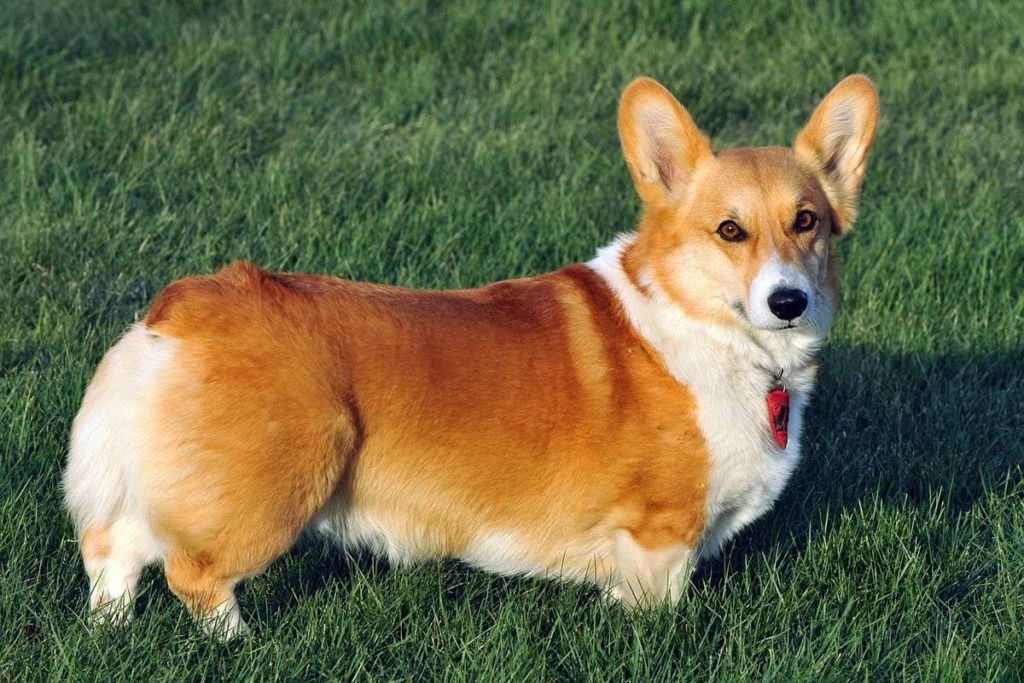
Let’s dive into the exciting world of Corgis and explore their intriguing history. These adorable canines originated in Wales, which is why they are also called Welsh Corgis. Interestingly, the Corgi breed comprises two distinct types – the Pembroke Welsh Corgi and the Cardigan Welsh Corgi.
Bred initially as cattle herding dogs, Corgis were later recognized by the British Kennel Club in 1925. Subsequently, in 1935, the dog registry acknowledged the two distinct breeds of Corgis.
While Corgis make excellent family pets, there are notable differences between Pembroke and Cardigan Welsh Corgis. For example, Pembroke Corgis tend to be shorter and have relatively more little ears than their Cardigan Corgi counterparts. In contrast, Cardigan Corgis are renowned for their big-boned frames, deep chests, and distinctive fox brush tails.
Regardless of their breed type, Pembroke and Cardigan Corgis have double coats and come in various colors, including red, sable, fawn, black, and white.
Origins and History of Pomeranian
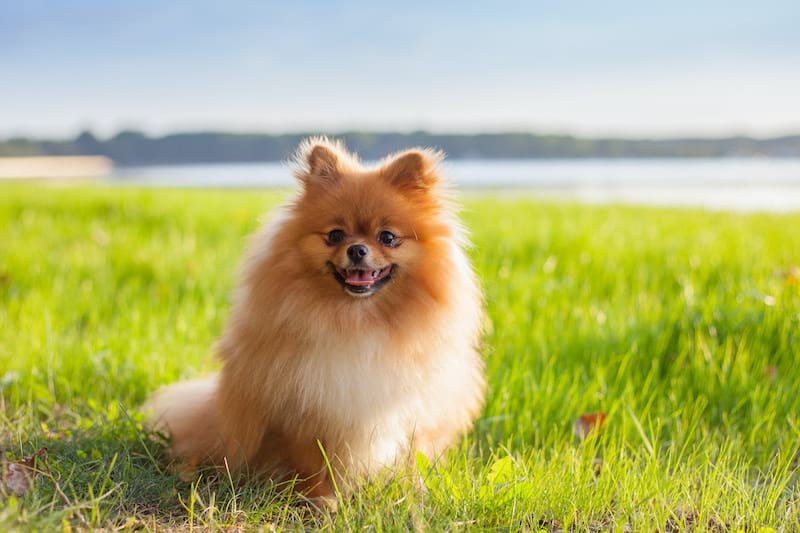
Once upon a time, in the land of Pomerania, there lived the Pomeranians. These small-sized canines belong to the Spitz family of dogs and can be traced back to the 18th century. The Pomeranians of yesteryear were different from the ones we see today. Believe it or not, they were bred as sled and guard dogs and could weigh up to 30 pounds! That’s right; the modern-day Poms have come far from their ancestors.
However, as time passed, the Zwerg Spitz, a smaller variant of the Pomeranian, was used for breeding them down to a smaller size. Experts suggest that this was done to make them suitable companion dogs.
Today, Pomeranians are considered toy dogs and weigh between 3 to 7 pounds. These canines are double-coated, have plumed tails, and have high-mounted erect ears.
Physical Appearance
Get ready for a burst of perplexity as we delve into the physical appearance of the Pomeranian Corgi Mix. This hybrid breed is a furry bundle of adorableness, and if you’re looking for a more in-depth analysis of their appearance, you’ve come to the right place.
Before we get started, it’s important to note that the physical appearance of the Corgi Pom can vary depending on the Welsh Corgi parent. We know it’s mind-boggling! We’ve split this section into two sub-headings to cater to our readers’ needs.
So, are you ready to dive into the fluffy, cute, and possibly confusing world of the Pomeranian Corgi Mix’s physical appearance? Let’s go!
1. Pembroke Welsh Corgi Pomeranian Mix
Are you ready to have your mind blown by the Pembroke Welsh Corgi Pomeranian Mix? Brace yourself because this compact pooch is a sight to behold! With a fluffy double coat that will make your heart melt, this canine’s head is proportional to its body, but it’s wider at the back and narrows down towards the nose to form a wedge-like appearance.
This variation of the Pom Corgi mix is bound to be smaller than their counterparts because Pembroke Corgis are shorter than Cardigan Corgis. That’s not all – this fluffy ball of cuteness also has a slightly more fox-like appearance due to his parentage.
The Pembroke Welsh Corgi Pomeranian Mix boasts a lush and fluffy two-layer coat that makes you want to snuggle them all day! Their topcoat is rough in texture and includes long hair that adds to their adorable appearance.
2. Cardigan Welsh Corgi Pomeranian Mix
Prepare for the Cardigan Welsh Corgi Pomeranian Mix – a slightly heavier hybrid with more extended appearances than the Pembroke Welsh Corgi Pomeranian Mix! Don’t be deceived because Cardigan Corgi Poms are still low-set like their Pembroke counterparts.
These pups come equipped with a dense, weather-resistant undercoat and a top coat of medium-length fur that’s rough to the touch. Their tails are fox-like with a substantial plume and a slight curl. Get ready to fall in love with this adorable and unique-looking designer breed.
Size, height, and weight
Before you bring home a Corgi Pomeranian, make sure you know more about their size deets than just that they’re tiny-to-medium pooches. Luckily, we’ve gathered all the relevant dimensions of the Corgi and Pomeranian Mix breed below for all enthusiasts.
Welsh Corgis, including Pembrokes and Cardigans, can weigh anything from 25 to 38 pounds and grow up to 10 to 12.5 inches in length. Meanwhile, Pomeranians are featherweights, weighing a mere 3 to 7 pounds and measuring up to 7 inches tall.
Because Corgi Pomeranians are a fusion of the one-of-a-kind Corgi and Pom breeds, they’ll inherit their size dimensions from both parents. As a result, these designer dogs can weigh anywhere from 8 to 28 pounds and measure between 7 to 12 inches at the withers.
| Gender | Height | Weight |
| Male | 7-12 inches | 10-28 pounds |
| Female | 7-10 inches | 8-26 pounds |
Coat colors and types
The Corgi Pomeranian Mix is a hybrid breed that boasts a double-layered coat with a dense undercoat that acts as a shield from the elements. The top coat has medium-length fur and is somewhat coarse to the touch.
In terms of color, the Corgi Pomeranian Mix comes in various hues. Some of the most common coat colors include black, white, brown, cream, and red. However, more unique coat colors, such as blue merle, sable, and brindle, can be found in this designer breed.
1. Black
The black Corgi Pomeranian Mix is quite the rarity! Black is uncommon in Pomeranians, and Corgis usually come in black and white or tri-color. Therefore, if you’re looking for a black Corgi Pom, expect to see some white and red fur mixtures.
2. Black and White
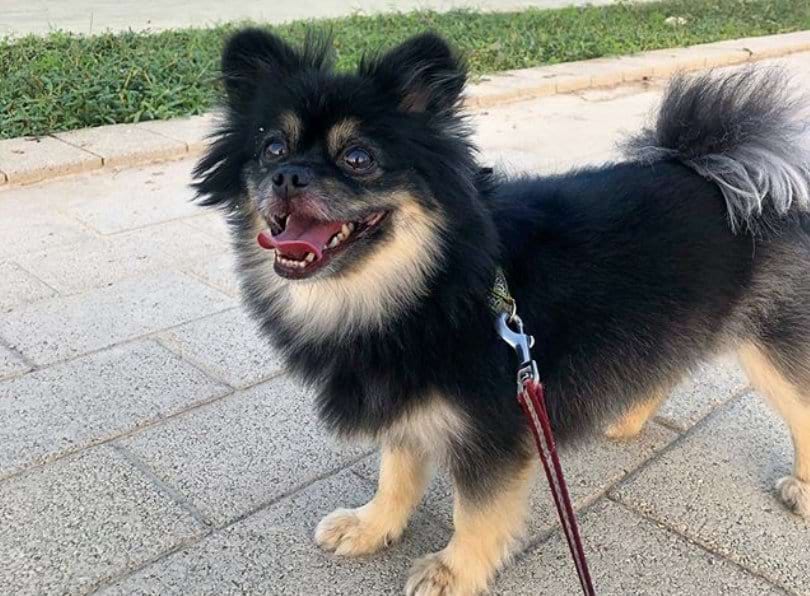
The black and white fur combo is a typical color pattern in Cardigan Corgis. These canines typically have black fur on their eyes, ears, neck, back, and tail regions, while the snout, muzzle, throat, and underbelly are white.
3. Merle
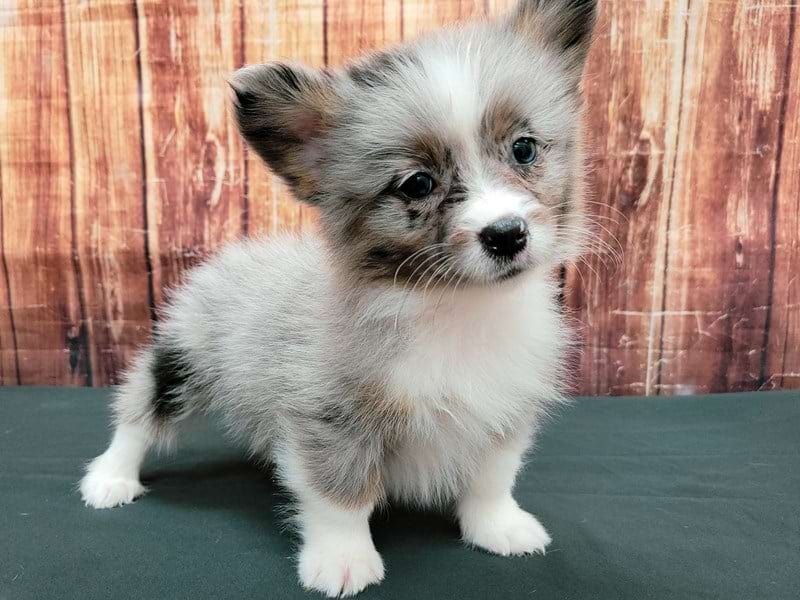
Merle is a fascinating pattern that can be seen on the coat of Corgi Pomeranians. It’s not so much a color as it is a unique arrangement of spots in contrasting hues. A light-colored base coat, often white or cream, serves as the background for dark-colored patches, which can be black, blue, or gray. The result is a beautiful, marbled effect that sets merle Corgi Poms apart from other breeds.
4. Tan
The tan coat color is like a darker cream shade. Corgi Pomeranian Mixes with tan fur will generally have this color on their head, back, saddle, and tail. Their underbelly, meanwhile, is often a lighter shade of cream, with or without any white markings.
5. Red

Red Corgi Poms possess a reddish-orange tone that can vary in intensity. The coat’s color can be entirely red or red tri-colored, depending on the genetic makeup inherited from the parents. This color variation may feature varying red, white, and black fur proportions.
Temperament and Personality
The temperament and personality of a Corgi Pomeranian Mix are a mix of the Pomeranian’s peppy and the Corgi’s dynamic nature. These intelligent creatures require both mental and physical stimulation to keep them happy.
Although the Corgi Pomeranian Mix is an excellent family dog, it’s important to note that it may not be suitable for families with young children or infants. They tend to do well with older individuals and teenagers.
However, their dynamic nature and working dog lineage require a lot of physical activity throughout the day. Without proper stimulation, they can quickly become bored and get into trouble.
Moreover, if left alone for an extended period, the Corgi Pomeranian Mix may engage in various mischievous activities. Despite this, they are lively, loving, and intelligent creatures that make excellent companions.
Is a Corgi Pomeranian Mix a good fit for families?
Corgipom dogs are considered excellent family dogs for several reasons. Their loyalty, affectionate nature, and need for companionship make them ideal family pets. While they may not suit infants, they get along well with toddlers and older children. Moreover, Corgipoms tend to be good with other pets in the house.
These dogs have a working dog gene from their Corgi lineage, which can benefit kids who like to train their pets. Children can teach their Corgipom dogs various tasks, such as fetching jackets or finishing vegetables. This can be a great way to keep the dog active and provide mental stimulation.
However, it’s important to note that Corgipoms need plenty of physical activity and mental stimulation to stay healthy and happy. They can become mischievous and get into trouble if left alone for too long. So, families with Corgipom dogs should be prepared to give them ample attention and exercise.
Is Corgi Pomeranian Mix aggressive?
Opposite the Corgi Pomeranian mix is a breed that can be described as outgoing and friendly. However, like humans, every dog has a unique personality that could make them more or less familiar. Corgi Poms can sometimes be wary of unfamiliar faces and animals at first, but they tend to warm up fast once they get to know someone. A Corgi Pom can grow into a friendly and loving companion with proper socialization and training.
Training

When training Corgi Mix with Pomeranian, it is crucial to keep them mentally stimulated and active. These pups have a natural inclination towards mischief, thanks to their Corgi and Pomeranian genes, and they’re not shy about making their presence felt.
Therefore, early socialization and training are essential for these little puppies. Enrolling them in a reputable obedience school is highly recommended if you’re a first-time pet owner to learn about canine training methods.
By observing how professional dog trainers handle and train puppies to follow commands, you’ll gain valuable insights to help you better prepare your Pomeranian Welsh Corgi Mix. Once you’ve learned enough and are confident, you can take charge of your pup’s education and shape their behavior positively.
Exercise Requirements
Pomeranian Corgi Mix dogs’ physical and mental health requires exercise to stay at optimal levels. Since Corgis and Pomeranians are high-energy dogs, a 30 to 60-minute walk is recommended to keep them physically fit. The Welsh Corgi and Pomeranian Mix, in particular, should be walked for at least 40 minutes daily.
Playing outside is also an excellent way for these furry friends to get exercise. It’s best to ensure that the yard is fully fenced in to keep them safe.
Taking your dogs to a doggy park is a good idea if you don’t have a backyard. It’s important to note that exercising puppies require a 5-minute walk per month of age. For instance, a four-month-old puppy should be walked for about 20 minutes, whereas a five-month-old pup should be walked for 25 minutes.
Living Conditions
Despite their significant personalities, the Corgi Pomeranian Mix can comfortably live in a small apartment. However, it’s worth noting that they can be pretty vocal. The Corgipom enjoys having its own space, which includes a cozy chew-proof dog bed, designated doggy bowls, and a collection of soft, squishy toys. They are not the type of dog that needs an ample, open space to run around.
These canines are creatures of habit, thriving when they have established routines. When it comes to climate, it’s best to keep them in moderate temperatures, as they have thick coats and are prone to shedding. This helps ensure they enjoy the weather and do not suffer from excessive shedding.
Grooming and Cleaning
The grooming and cleaning needs of the Pomeranian and Corgi Mix are something every owner should know. This breed has a unique double coat that requires regular brushing to prevent tangling and matting. This grooming requirement is also applicable to Corgi Pom puppies.
As an owner, it’s best to set aside 15 to 20 minutes to brush your furry friend at least twice or thrice a week.
In addition to regular brushing, bathing your furry companion once every three weeks is recommended. However, you should avoid washing him too often as it can cause dry, irritated, and inflamed skin. You can use dog grooming wipes between baths to clean your dog’s paws, skin, fur bottom, and face.
When it’s time to bathe your puppy, using a dog shampoo containing natural and organic ingredients is essential. The shampoo should keep your Pomeranian and Corgi Mix’s skin and coat clean, moisturized, and smelling great.
Nail trimming is another crucial aspect of grooming for Pomeranian Corgi dogs.
Brushing your Corgi Pom’s teeth daily is essential for maintaining good oral hygiene. If your schedule is too busy, aim to brush your teeth at least 2 to 3 times a week.
Lastly, you should regularly check your Pomeranian and Corgi Mix’s bum area to ensure it’s clean. Sometimes, poop can get stuck to your canine’s fur if the fur is too long.
| Grooming Technique | Frequency |
| Hair Brushing | 3 times per week (15-20 min/session) |
| Bathing | Every 3-4 weeks |
| Nail Trimming | Every 2 weeks or as needed |
| Every 2 weeks or as needed | Once daily |
| Eye Care | As needed |
| Ear Care | Once a month |
Food and Diet
Feeding your Corgipom the right food keeps him healthy and energized. High-energy dogs like the Corgipom need a nutritious and well-balanced diet with protein as the key ingredient.
Deciding what to feed your furry friend can be overwhelming, but you can always consult your vet for recommendations. Remember that Pomeranians and Corgis have sensitive stomachs, so choosing the right type of food is essential.
Common Health Issues
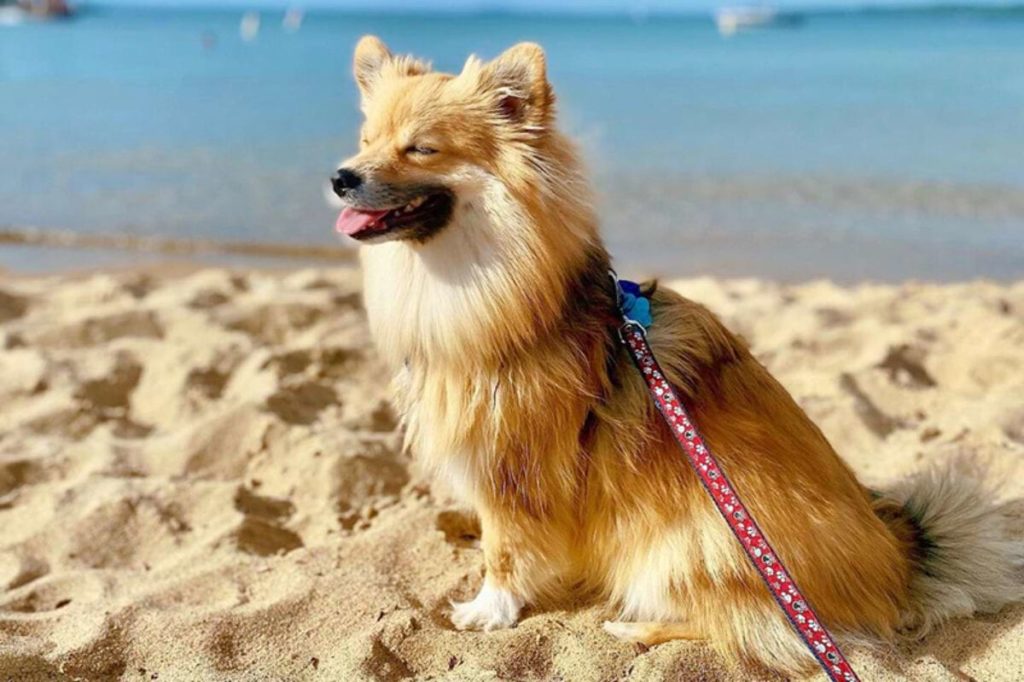
1. Elbow and Hip Dysplasia
Elbow and hip dysplasia is standard among Corgi Poms and other low-set dog breeds. This disease affects the proper development of your fluffy friend’s joints, and it can cause arthritis, a severe condition that may lead to limping and pain while moving. Look out for symptoms like stiffness in your pup’s gait, discomfort when sitting or proceeding, and limping. If you notice any of these, contact your vet right away.
2. Canine Degenerative Myelopathy (DM)
Get ready to learn about another health issue your furry friend may experience – canine degenerative myelopathy (DM). This disease mainly targets nerve function in the hind legs of your K9 buddy.
One of the common symptoms of DM is weakness in your dog’s hind legs, which can lead to a loss of control and incontinence. In the later stages of the disease, your dog may suffer from paralysis, which can devastate you and your pet.
3. Heart Disease
Prepare to be bewildered by the fact that Pembroke Corgis are predisposed to heart disease. This medical condition can be fatal for our four-legged friends, causing pulmonary hypertension that leads to coughing, shortness of breath, and hind limb weakness. If you notice these signs, you should consult your vet immediately to start treatment. Remember that regular checkups can help detect heart disease early on and save your furry pal’s life.
4. Epilepsy
Epilepsy is a gnarly neurological disease that Corgi Poms can acquire. It usually kicks in when they’re between five to three years old. No one knows why this is happening, but clinical symptoms can arise when it does, like stiffening of the legs or neck, falling over, trembling, and losing bladder control.
5. Hypoglycemia
Listen up, pet parents! Low blood sugar, aka hypoglycemia, can be a real threat to your tiny, toy Pomeranians. These petite pups are prone to sudden drops in their blood sugar levels, which can cause severe symptoms like seizures, shaking, twitching, and even loss of consciousness.
And let’s remember, a poor diet can make things even worse. So make sure your Pomeranian’s diet is on point and he’s getting all the necessary nutrients. Remember, prevention is key!
6. Patella Luxation
Woof! Patella luxation is a condition that can affect your furry friend’s kneecaps, particularly Corgi Poms. When your dog’s patella luxates, it temporarily slips or shifts from its joint. As a result, your canine may suddenly skip or hop during a run or even run on three legs. This can happen if the patella’s groove is too shallow or the patella’s tendon is abnormally stretched. Patella luxation can range from mild to severe, and in some cases, surgical intervention may be required to correct it. Keep a close eye on your pup’s mobility and consult your vet if you notice any unusual movements or behaviors.
7. Reverse Sneezing
Reverse sneezing is a peculiar respiratory phenomenon that can happen to canines. It occurs when a dog inhales air too quickly, resulting in a sudden, loud, and snort-like sound that can be startling to some pet owners. This strange occurrence is often related to an irritation in the palate area or larynx. It can stem from various causes, such as allergic reactions to pollen, smoke, or perfumes.
How Long Does Pomeranian Corgi Mix Live?
The Pomeranian Corgi Mix, also known as the Corgi Pom, has an average lifespan of about 12 to 15 years, but this is a rough estimate. It’s important to remember that each dog’s lifespan is unique and can be affected by various factors such as genetics, nutrition, exercise, and overall health.
Therefore, providing your beloved furry friend with proper care, regular checkups with the vet, and a nutritious diet can extend their lifespan beyond expectations. With a little extra attention and love, there is no reason why your Corgi Pom can’t live a long and healthy life filled with fun and adventures.
How Much Is The Price of Corgi Pomeranian Mixes?
The price of a Corgipom can fluctuate wildly and is influenced by various factors. For instance, the cost can depend on the dog’s age, lineage, color, and breeder. Corgipoms purchased from a reputable breeder can cost anywhere between $500 to $1,500.
On the other hand, adopting a Corgipom from a rescue shelter is often free or available at a lower cost. So, if you’re looking for a budget-friendly option, adoption is a great way to save money while giving a furry friend a forever home.
Is Corgi Pomeranian Mix Right For Me?
Are you seeking the perfect furry addition to your family? The Pom Corgi Mix is what you’re looking for. This breed is ideal for families with older children or adults. However, this breed may not suit your household if you have young children or will only be around for a short period.
Corgi Poms are loyal and outgoing and have excellent guarding instincts, making them great companions. However, they may not be the ideal breed for first-time dog owners as they have specific needs that require experienced handling. If you’re willing to invest in the proper care, this breed can be a great addition to your home.
List of dogs that are similar to Corgi Pomeranian Mix
- Corgi-Blue Heeler Mix
- Corgi-Dalmatian Mix
- Corgi-St. Bernard Mix
- Corgi-French Bulldog Mix
- Corgi-Yorkie Mix
- Pomeranian-French Bulldog Mix
- Pomeranian-Jack Russell mix
Frequently Asked Questions
Is the Corgi Pom Hypoallergenic?
No, it’s not. The Corgi Pom, with its double coat, is known for shedding profusely, making it unsuitable for those seeking a hypoallergenic dog.
If you’re among those who suffer from pet dander allergies, it’s advisable to visit a breeder and spend time with Pomeranian Corgie Mix puppies before making a decision to bring one home. Testing the waters is crucial to ensure compatibility with your allergies.
Do Corgi Pomeranian Mixes Shed a Lot?
Yes, they do shed. Corgi Pomeranian Mixes are known to be heavy shedders due to their double coat. They shed moderately throughout the year, with more intense shedding occurring in the spring and fall.
These shedding episodes can result in a considerable amount of fur in your home. However, regular brushing can be an effective way to manage shedding. Using a de-shedding brush can help remove loose fur from your dog’s undercoat.
During the peak shedding seasons in spring and fall, your Corgi Pom may experience significant hair loss for about two weeks.
Do Corgi Pomeranian Mixes Bark a Lot?
Yes, they do. Corgi Pomeranian mixes tend to be quite vocal, inheriting the barking tendencies of their Corgi and Pomeranian parents. They often bark at various stimuli, including doorbells, loud noises, and passersby. While this can be useful for watchdog purposes, it may pose challenges for you and your neighbors.
However, there is hope! Corgi Pomeranians are highly intelligent, making them trainable. With proper training and effort, you can curb their barking tendencies and transform them into well-behaved and quieter pets. So, don’t let their barking inclination deter you from adopting a Corgipom; just be prepared to invest time in training.
Are Pomeranian Corgi Mixes Intelligent?
These furry friends have inherited their exceptional intellect from their parent breeds, who are already super-smart. As curious dogs, Corgipoms love to explore and learn in a stimulating environment. They are quick learners and can easily pick up on training.
What is another name for Corgi Pomeranian Mix?
A Corgi Pomeranian Mix, also known as a Pom Mix Corgi, Pomeranian Corgi Mix, Corgi Pom, Corgi Pomeranian, or Corgiranian, has quite a few notable monikers that are sure to grab anyone’s attention.
These various titles can be used interchangeably, each with its unique ring. So, whether you prefer the Corgi Pomeranian or the Pomeranian Corgi Mix, every fancy has a name.
Conclusion
In conclusion, the Corgi Pomeranian Mix is a delightful breed that combines the best of both worlds – the Pomeranian’s playful nature and the Corgi’s loyal personality. They make great family pets, especially those looking for a small dog with a big personality.
While they may have some health concerns to be aware of, these mixed breeds can live long and happy lives with proper care and attention. Whether you’re a first-time pet owner or a seasoned dog lover, the Corgi Pomeranian Mix is a breed worth considering if you’re looking for a furry friend that will bring joy and companionship into your life.

Pingback: Corgi Pug Mix 101: Everything You Need to Know 2023
Pingback: Sable Corgis 101: Everything You Need to Know 2023
Pingback: Boxer Corgi Mix: Everything You Need to Know 2023
Pingback: Corgi Yorkie Mix: Interesting Facts You Need to Know 2023
Pingback: St. Bernard Corgi Mix: Interesting Facts You Need to Know 2023
Pingback: Do Corgis Shed? Helpful Tips You Need to Know 2023
Pingback: Fluffy Corgi: Unveiling the Beauty of this Rare Breed 2023
Pingback: Blue Merle Corgi: Exploring the Fascinating World of Corgis 2023
Pingback: French Bulldog Corgi Mix: Top Things You Need to Know 2023
Pingback: French Bulldog Pomeranian Mix: Interesting Guides 2023
Pingback: Jack Russell Pomeranian Mix: Discover the Adorable Breed 2024
Matchless topic, it is interesting to me))))
You were visited with excellent idea